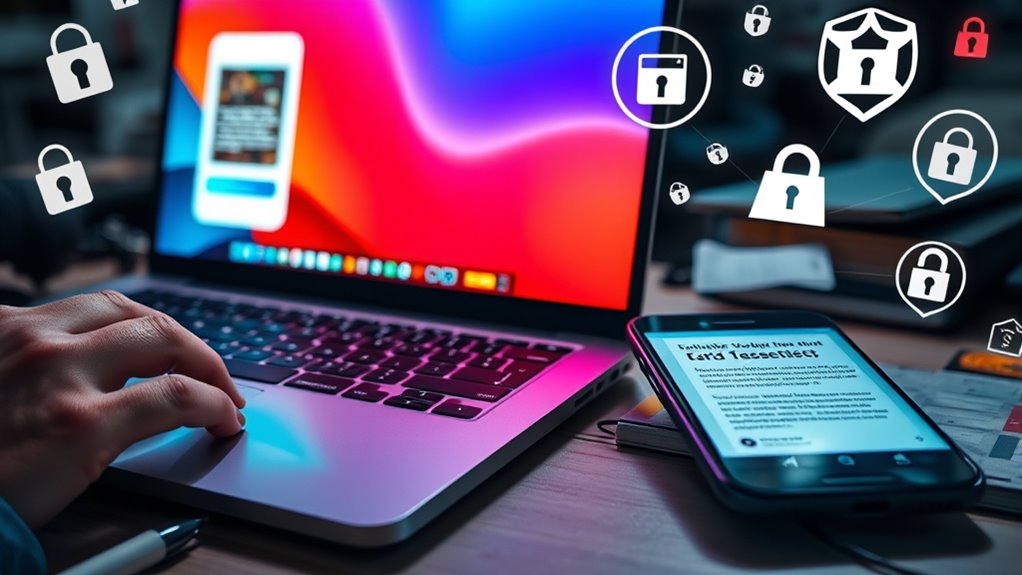Your loyalty points are at risk because hackers exploit weak security measures, such as using simple passwords or reusing passwords across accounts. Public Wi-Fi networks and outdated devices can expose your accounts to interception and unauthorized access. Without strong protections like two-factor authentication and regular security checks, cybercriminals can drain your points by hacking into your digital wallets. To keep your rewards safe, it’s essential to understand how these vulnerabilities work and take proactive steps. If you keep exploring, you’ll discover how to better protect your points.
Key Takeaways
- Weak or reused passwords can be exploited by hackers to access loyalty accounts.
- Lack of two-factor authentication increases vulnerability to unauthorized access.
- Public Wi-Fi networks can intercept data, risking theft of login credentials.
- Digital wallets and accounts may lack robust security measures, making them easier targets.
- Outdated devices and software can be exploited by cybercriminals to compromise accounts.

Loyalty points are valuable assets that can considerably enhance your shopping experience, but they also pose security risks if not properly protected. When you store your points in digital wallets or online accounts, you’re essentially holding sensitive information that hackers might target. Digital wallets are convenient, but their convenience can be a double-edged sword if you don’t take proper precautions. If your digital wallet isn’t protected with strong, unique passwords or two-factor authentication, it becomes an easier target for cybercriminals seeking to exploit vulnerabilities. Account hacking is a real threat; once a hacker gains access, they can drain your loyalty points, making it impossible to redeem rewards or even causing you to lose accumulated benefits altogether. Cybercriminals often use phishing schemes or malware to steal login credentials, so if you’re not vigilant, your loyalty account could be compromised without you knowing it until it’s too late.
Protect your loyalty points by using strong passwords and enabling two-factor authentication to prevent account hacking.
Many people overlook how attractive loyalty points are to hackers because they’re a form of digital currency that holds real value. Unlike cash, which is often protected by bank security measures, loyalty points are usually stored in accounts that may not have the same level of security. If you reuse passwords across multiple accounts, you’re increasing the risk of account hacking. Hackers can use stolen credentials from other breaches to access your loyalty accounts, especially if you haven’t enabled additional layers of security. Once inside, they can transfer points to their own accounts or redeem rewards in your name, leaving you with a loss and no simple way to recover what’s been stolen.
Another aspect to consider is how insecure public Wi-Fi networks can expose your digital wallets to threats. When you access your loyalty accounts over an unprotected network, hackers can intercept your data, potentially gaining access to your login information. This makes it essential to use secure, private connections and keep your devices updated with the latest security patches. Additionally, many loyalty programs don’t have robust security measures, making it even easier for cybercriminals to exploit weak points in their systems. If your account becomes compromised, you might face a lengthy process to recover your points or dispute fraudulent activity, which isn’t always guaranteed. Implementing additional security measures can significantly reduce your risk of theft and unauthorized access.
In short, your loyalty points are at risk of being stolen if you don’t take security seriously. Protecting your digital wallets, avoiding account hacking, and practicing good cyber hygiene are vital steps to ensure your rewards stay safe. Always use strong passwords, enable two-factor authentication, and stay alert for suspicious activity. Your loyalty points are valuable—treat them as such by safeguarding your accounts against cyber threats.
Frequently Asked Questions
Can Hackers Access Loyalty Account Details Through Social Engineering?
Yes, hackers can access your loyalty account details through social engineering. They often use phishing scams to trick you into revealing sensitive information or may attempt account impersonation by pretending to be a trusted company representative. Stay vigilant, avoid clicking suspicious links, and verify identities before sharing details. Protect your loyalty points by being cautious and aware of common social engineering tactics hackers use to compromise accounts.
What Are Common Signs of Loyalty Point Theft?
You might notice your loyalty points are slipping away if you see unexpected deductions or unfamiliar activity. These are subtle signs of potential fraudulent activity, so it’s wise to keep a close eye on your account monitoring. Sudden changes in point balances or unauthorized transactions often indicate your rewards are being accessed without permission. Stay vigilant, review your account regularly, and act swiftly to protect your valuable rewards.
How Often Should I Change My Loyalty Account Passwords?
You should update your loyalty account passwords regularly, ideally every three to six months. Regular password updates help you stay ahead of potential threats and guarantee secure practices. Make sure your passwords are strong, unique, and avoid reusing them across different sites. By consistently changing your passwords, you reduce the risk of unauthorized access and keep your loyalty points safe from theft.
Are Third-Party Apps Safe for Managing My Loyalty Points?
You might wonder if third-party apps are safe for managing your loyalty points. While secure app integrations can make tracking easier, they also raise data privacy concerns. Always verify that the app uses encryption and has good reviews. Avoid sharing your login details and connect only with trusted services. By staying cautious, you protect your points and personal information from potential threats.
Do Loyalty Programs Share Security Practices Publicly?
Many loyalty programs don’t share their security practices publicly, making it hard to know how they protect your data. You should check their privacy policies to see if they mention data encryption and other security measures. Programs that prioritize your security typically outline their practices clearly, giving you peace of mind. Always stay cautious, and don’t hesitate to ask customer service about their security protocols to better protect your points.
Conclusion
To protect your loyalty points, always stay vigilant against scams and use strong, unique passwords. Did you know that 81% of data breaches involve stolen or weak passwords? That’s a huge risk for your valuable rewards. By keeping your account details secure and monitoring your activity regularly, you reduce the chance of theft. Don’t let hackers steal what you’ve earned—stay cautious and safeguard your loyalty points today.









